Mountain Kilimanjaro
Conquering the Mighty Kilimanjaro: A Journey to the Roof of Africa
Introduction:
Embarking on a journey to summit Mount Kilimanjaro, the highest peak in Africa, is an experience that leaves a lasting imprint on the soul. Rising majestically above the Tanzanian plains, this dormant volcano stands as a symbol of awe-inspiring natural beauty and human determination. Join me as we delve into the enchanting world of Kilimanjaro and explore the challenges, triumphs, and breathtaking vistas that await those who dare to undertake this remarkable adventure.
1. The Mighty Monarch of Africa:
Standing at an astounding height of 5,895 meters (19,341 feet), Mount Kilimanjaro is not only Africa’s tallest peak but also the highest freestanding mountain in the world. Located in northeastern Tanzania, near the border with Kenya, Kilimanjaro’s snow-capped summit beckons climbers from all corners of the globe, luring them with promises of unparalleled views and an unforgettable journey.
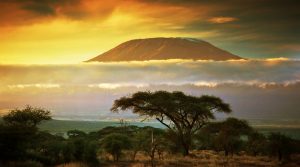
1.1 Kilimanjaro’s Formation:
Mount Kilimanjaro is a stratovolcano formed by successive volcanic eruptions over thousands of years. Its distinct three volcanic cones, Kibo, Mawenzi, and Shira, contribute to its remarkable presence and geological significance. While the volcano is currently dormant, its history of volcanic activity has shaped the landscape and provided a unique environment for diverse ecosystems to thrive.
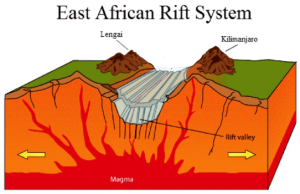 2. The Ecological Diversity:
2. The Ecological Diversity:
Mount Kilimanjaro is an ecological wonderland, comprising five distinct climatic zones, each with its unique flora and fauna. Starting with the lush rainforests at the mountain’s base, trekkers gradually ascend through moorlands, alpine deserts, and rocky terrains before reaching the final arctic summit. This incredible diversity presents an ever-changing landscape that astounds and captivates those who venture forth.
2.1 Rainforest Zone:
The journey to the summit begins in the rainforest zone, where dense vegetation, towering trees, and a rich array of wildlife create a vibrant and humid environment. Trekkers are treated to the sights and sounds of unique plant species, such as giant heathers and African mahogany, as well as encounters with monkeys, colorful birds, and elusive mammals.
2.2 Heath and Moorland Zone:
Ascending further, the landscape transitions into the heath and moorland zone, characterized by heather-covered slopes, tussock grasses, and scattered giant lobelias. This unique ecosystem provides a habitat for unique plant species adapted to the harsher conditions. Here, trekkers may encounter wildlife such as hyraxes, chameleons, and a variety of bird species.
2.3 Alpine Desert Zone:
As climbers ascend beyond the moorland, they enter the alpine desert zone, a surreal and barren landscape devoid of trees and marked by volcanic rocks and boulders. The air becomes thinner, and the temperature drops significantly. Despite the apparent desolation, certain plant species, including resilient mosses and lichens, manage to survive, while endemic rodents like the Kilimanjaro shrew scuttle across the rocky terrain.
2.4 Arctic Zone:
The final leg of the ascent leads trekkers into the arctic zone, also known as the summit zone. This icy wilderness is characterized by permanent glaciers, snowfields, and bitter cold temperatures. The stark beauty of the glaciers, such as the Northern Icefield and Furtwängler Glacier, adds a touch of otherworldliness to the journey.
 3. The Trekking Routes:
3. The Trekking Routes:
Kilimanjaro offers several routes, each with its own charms and challenges. The choice of route determines the duration, difficulty level, and overall experience of the climb
. Considerations such as scenery, acclimatization opportunities, and foot traffic play a role in selecting the ideal path to the summit.
3.1 Marangu Route:
Known as the “Coca-Cola” route, the Marangu Route is the most popular and relatively easier option. It follows a well-trodden path, and climbers stay in basic huts along the way. While it offers a straightforward ascent, proper acclimatization is crucial, and the shorter duration can sometimes lead to a lower success rate.
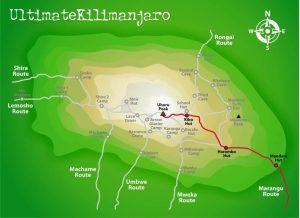 3.2 Machame Route:
3.2 Machame Route:
The Machame Route, often called the “Whiskey” route, is renowned for its stunning scenery and a higher success rate compared to the Marangu Route. It traverses diverse landscapes, including the lush rainforest, rocky ridges, and alpine desert. Trekkers camp in tents, immersing themselves in the wilderness throughout the journey.
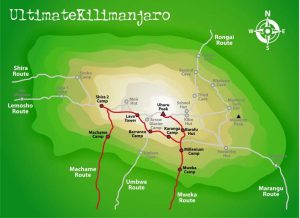 3.3 Lemosho and Northern Circuit Routes:
3.3 Lemosho and Northern Circuit Routes:
The Lemosho Route and its extended version, the Northern Circuit Route, provide a more secluded and pristine experience. These routes offer ample time for acclimatization, as the longer durations and gradual ascent allow climbers to adapt to higher altitudes. The Lemosho Route showcases panoramic vistas and diverse ecosystems, while the Northern Circuit offers a complete circumnavigation of the mountain.
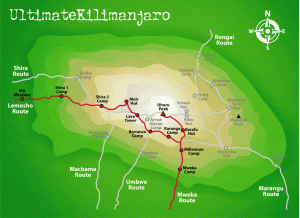 3.4 Rongai Route:
3.4 Rongai Route:
The Rongai Route approaches Kilimanjaro from the north, providing trekkers with a less crowded alternative. This route is known for its scenic beauty and offers opportunities for wildlife sightings, including the chance to spot antelopes and elephants in the surrounding wilderness. The Rongai Route is a great option for those seeking a quieter and more remote experience.
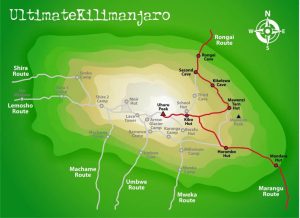 4. Physical and Mental Preparation:
4. Physical and Mental Preparation:
Ascending Kilimanjaro demands physical fitness and mental fortitude. Preparing for the climb involves a combination of cardiovascular exercises, strength training, and acclimatization hikes to build endurance and enhance your body’s capacity to adapt to higher altitudes. It is crucial to focus on strengthening the legs, core, and cardiovascular system to endure long hours of trekking uphill. Mental preparation, including determination and a positive mindset, plays a crucial role in overcoming the physical and emotional challenges along the way.
4.1 Physical Training:
Preparing for Kilimanjaro requires a dedicated fitness regimen. Regular cardio exercises, such as running, hiking, or cycling, help build endurance. Strength training exercises targeting the legs, core, and upper body enhance overall fitness. Incorporating flexibility and balance exercises, like yoga or Pilates, can also aid in preventing injuries during the climb.

4.2 Altitude Training and Acclimatization:
One of the key challenges of climbing Kilimanjaro is acclimatizing to the high altitude. Gradual ascent and proper acclimatization hikes are crucial to prevent altitude sickness. Incorporating hikes at higher altitudes before the climb can help condition your body to lower oxygen levels. Adequate hydration, a nutritious diet, and proper rest are essential during the climb to aid in acclimatization.
5. Altitude and Acclimatization:
As trekkers ascend Kilimanjaro, they encounter the effects of high altitude. Acclimatization, the process of adjusting to decreasing oxygen levels, becomes vital to prevent altitude sickness. The climb should be done gradually to allow the body to adapt and reduce the risk of complications. Experienced guides and support teams ensure a safe journey, monitoring climbers for any signs of altitude-related illnesses and recommending appropriate actions.
5.1 Common Altitude-Related Illnesses:
Altitude sickness, also known as acute mountain sickness (AMS), is a common concern during the Kilimanjaro climb. Symptoms may include headaches, nausea, dizziness, and fatigue. In
severe cases, altitude sickness can progress to high altitude pulmonary edema (HAPE) or high altitude cerebral edema (HACE), both of which can be life-threatening. It is crucial to recognize the signs and seek immediate medical attention if necessary.
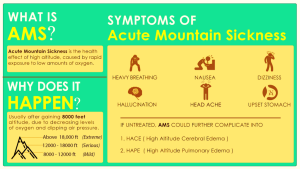 5.2 Preventing Altitude Sickness:
5.2 Preventing Altitude Sickness:
To prevent altitude sickness, climbers should ascend gradually, allowing their bodies to acclimatize to the changing conditions. This may involve rest days at certain altitudes, as well as undertaking acclimatization hikes to higher points and descending to lower elevations for sleep. Staying hydrated, avoiding alcohol and sleeping pills, and eating a balanced diet contribute to a successful acclimatization process.
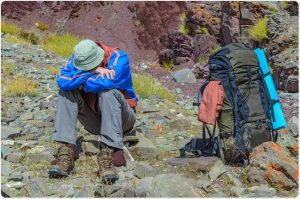 6. The Summit: Uhuru Peak:
6. The Summit: Uhuru Peak:
Reaching the summit of Kilimanjaro is an awe-inspiring moment that transcends words. The final push to Uhuru Peak, the highest point on the mountain, is an arduous endeavor, often conducted during the pre-dawn hours to witness the breathtaking sunrise from the roof of Africa. As you navigate the steep and rocky slopes, battling fatigue and thinning air, a sense of accomplishment and euphoria gradually washes over you. Embracing the spirit of determination, you push forward, driven by the desire to conquer this monumental challenge. Finally, as you stand atop the world, surrounded by glaciers and sweeping views of the African continent, a profound sense of achievement and gratitude fills your being, making the arduous journey worthwhile.
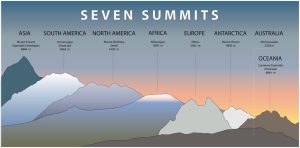
7. Cultural Encounters:
Climbing Kilimanjaro is not merely about conquering a mountain; it’s also an opportunity to engage with the local Tanzanian culture. Interacting with the warm and welcoming porters, guides, and fellow trekkers fosters a sense of camaraderie and an appreciation for the rich heritage of the region. The porters, often referred to as the unsung heroes of Kilimanjaro, carry the weight of supplies and equipment, enabling trekkers to focus on the climb. Their strength, resilience, and infectious spirit add depth and inspiration to the journey. Immersing yourself in the vibrant traditions, music, and cuisine of Tanzania provides a profound cultural experience that complements the physical and mental challenges of the climb.
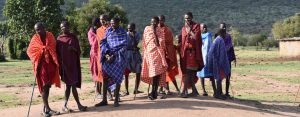 8. Environmental Conservation:
8. Environmental Conservation:
As adventurers, it is essential to prioritize responsible and sustainable travel. Kilimanjaro’s popularity has led to increased foot traffic, posing challenges to the delicate ecosystem. Choosing responsible tour operators who adhere to Leave No Trace principles, minimizing waste, and respecting the environment is crucial. By respecting the mountain’s fragile ecosystems and supporting local conservation efforts, climbers can ensure that future generations can experience the magnificence of Kilimanjaro.
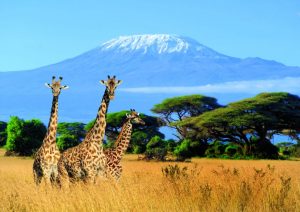 Conclusion:
Conclusion:
Ascending Mount Kilimanjaro is an extraordinary endeavor that pushes the boundaries of physical and mental endurance, while also immersing you in the untouched beauty of the African continent. The journey challenges and transforms you, leaving indelible memories and a deep connection with nature. As you descend the slopes, forever changed by the experience, you carry with you the spirit of Kilimanjaro, a testament to the heights one can reach when they dare to dream, embrace the unknown, and tread lightly upon the earth.
